Entertainment Venue and Café Tivoli
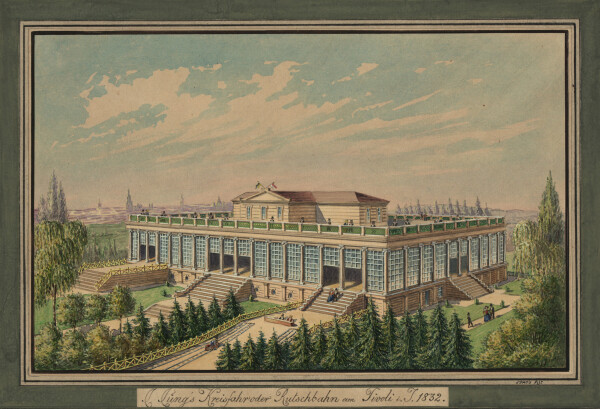
Jakob Alt: Slide at the Tivoli, 1832
© Wien Museum
The café and entertainment venue of Viennese high society, known as the Tivoli, was an important retreat for Gustav Klimt in his daily routine. His stays there are documented by photographs taken by Moriz Nähr and by numerous picture postcards.
A Slide and Other Amusements
In 1830, the Berlin slide entrepreneurs Friedrich Gericke and Ernst Wagner established the entertainment venue Tivoli east of the castle grounds of Schönbrunn Palace (Tivolistraße 79 / corner of Hohenbergstraße 58, in Vienna-Meidling, 12th District). The plot had an existing classicistic countryside villa with an imposing viewing platform affording impressive views of Vienna and its environs. Initially, the venue’s biggest sensation and crowd puller was a four-track slide incorporated into the extensive gardens. The Tivoli was opened on 5 September 1830 by the imperial couple.
The entertainment venue initially also offered musical performances, dance nights and cockfights, but soon became unprofitable. Shortly after opening, the establishment changed hands several times, with Johann Junge amongst one of its proprietors. In 1844, Franz Lechner opened the café Klein-Tivoli with dairy products from its own dairy farm. In 1873, the Tyrolean Johann Wallner leased the area, buying it 15 years later. Wallner carried out considerable structural adaptations, including the addition of an impressive wooden pavilion south of the existing café, which was originally designed and built for the “Vienna World’s Fair” (1873) or the “Internationale Ausstellung für Musik- und Theaterwesen” [“International Exhibition for Music and Theater”] (1892). This is how Klimt would have known the establishment, which now accommodated close to 5,000 guests.
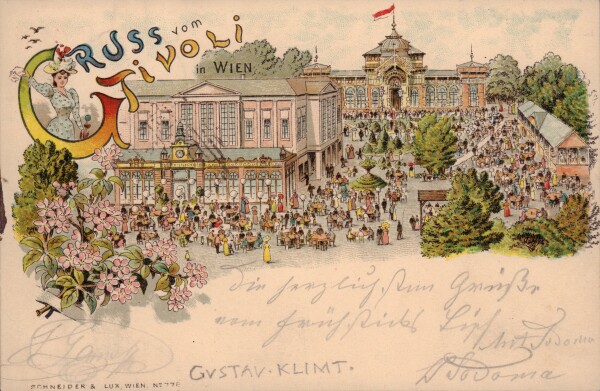
Anton Sodoma: Picture Postcard from Anton Sodoma in Vienna to Ferdinand Sodoma in Krieglach, co-signed by Wenzel Sodoma and Gustav Klimt, 08/15/1895, Markus Weissenböck
© Markus Weissenböck, Salzburg
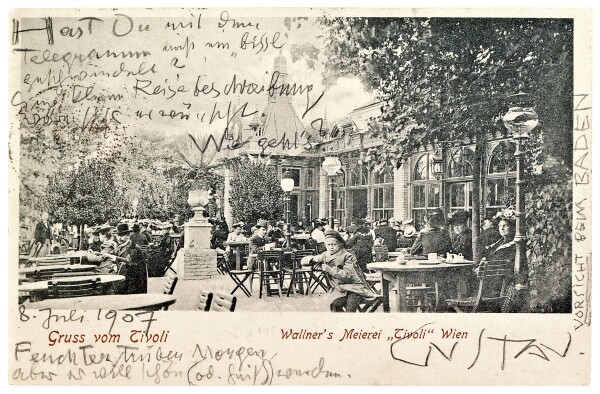
Gustav Klimt: Picture postcard from Gustav Klimt in Vienna to Emilie Flöge in Litzlberg am Attersee, 07/08/1907, private collection
© Leopold Museum, Vienna
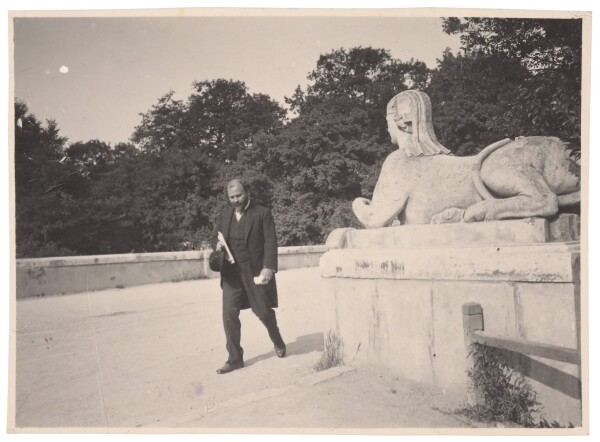
Moriz Nähr (?): Gustav Klimt crosses the Tivoli Bridge, circa 1914, Privatbesitz, courtesy Klimt-Foundation, Wien
© Klimt Foundation, Vienna
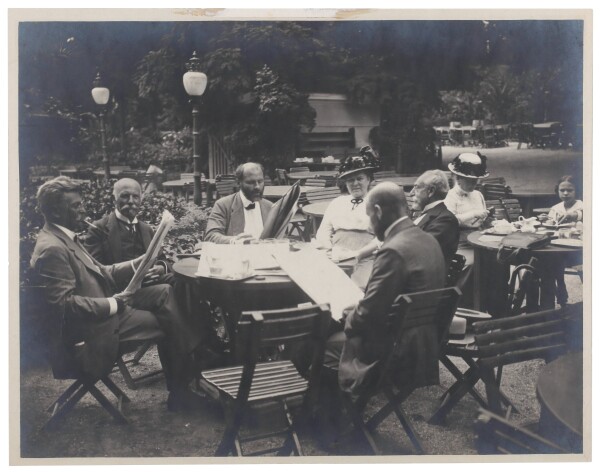
Moriz Nähr (?): Gustav Klimt with the "Breakfast Party" at Wallner's Meierei Tivoli, presumably circa 1914, Klimt Foundation
© Klimt Foundation, Vienna
“Best regards from the Tivoli.” Klimt’s Stays
The café played a part in Klimt’s life already from 1895, as suggested by a Greetings from the Tivoli in Vienna picture postcard by Anton Sodoma, which Klimt co-signed. Klimt himself wrote more than 75 picture postcards and letters to Emilie Flöge and acquaintances from this retreat. Snapshots taken by his favorite photographer and companion, Moriz Nähr, show him not only sitting in the garden with other guests reading his newspaper but also on his way to the café, crossing the bridge Tivolibrücke.
“Klimt was an early riser who loved exercise; early in the morning, he would walk to Café Tivoli next to Schönbrunn, which, with its atmosphere of Old Vienna, appealed to him, this most modern of artists, the most. An illustrious regular, he was nourished and cherished there; an opulent breakfast, in which a large portion of whipped cream played the leading part, had to sustain him for the whole day,”
Carl Moll recalled in 1943. The painter and member of the artists’ association Hagenbund, Sigmund Walter Hampel, reminisced:
“He [Klimt] knew exactly when pigs were killed at the Tivoli, and was always present when, on the evenings of such slaughtering days, there were fresh sausages to be had.”
We can assume that Klimt, departing from his apartment at Westbahnstraße 36 (Vienna-Neubau, 7th District), either walked away from the center towards present-day Grünbergstraße, or at times took the new city railway, getting off at its Schönbrunn stop. From there, he could walk along the street to Tivolibrücke, or stroll via the Meidlinger Tor, past the Neptun fountain across the Tivolibrücke. He liked to write about the impressions gathered during these city walks:
“[…] A heavy scent of rain and linden trees in Schönbrunn this morning, feeling slightly gloomy […]”
For the Jugendstil artist, the Tivoli was an ideal, temporary retreat, which he liked to visit throughout the seasons. Of the view over Vienna, Klimt wrote:
“I should really take writing paper with me to breakfast – I would have much more time and peace up here than in the studio […]”
The Tivoli was also an ideal destination for spontaneous day trips:
“Dear Emilie! We are not going to [Otto] Wagner’s today. […] I will be at the Tivoli (resting day.).”
Klimt could socialize there amongst members of his “skittles party” and “breakfast party,” which included the lawyer Dr. Friedrich Hetzer and his family, the painters Max Oppenheimer and Remigius Geyling, as well as Moriz Nähr and likely also Egon Schiele. At times, these gatherings became too large and boisterous for Klimt, prompting him to make his way back. Klimt would walk through the castle grounds of Schönbrunn Palace, starting at the height of the Gloriette, past the zoo and palm house towards Hietzinger Tor. From 1911 onwards, he would take a short walk from there to his studio at Feldmühlgasse 11 (formerly 9, Vienna-Hietzing, 13th District).
The Tivoli’s Decline
Over the course of the 20th century, the entertainment venue increasingly lost in importance. Shutdowns on account of the wars were followed by refurbishments and the demolition of the wooden pavilion. In 1967, the facility closed down permanently. The remaining structures of the Tivoli were destroyed in a fire in 1980, and were removed in 1991. Today, the area of the former fairground Tivoli is the site of a retirement home.
Literature and sources
- Sandra Tretter, Peter Weinhäupl: Gustav Klimt und sein »Werkstattgarten«, in: Irmi Soravia (Hg.): Hietzing, Vienna 2019, S. 135-146.
- Peter Weinhäupl: Klimts Wege von Neubau nach Hietzing – eine innerstädtische Stadt-Land-Flucht, in: Sandra Tretter, Peter Weinhäupl, Felizitas Schreier, Georg Becker (Hg.): Gustav Klimt. Atelier Feldmühlgasse 1911–1918, Vienna 2014, S. 85-97.
- Andreas Berthold, Ingrid Mader: Ein historistischer Holzpavillon auf dem Tivoli in Wien-Meidling: Geschichte und Rekonstruktion, in: Fundort Wien. Berichte zur Archäologie, Vienna 2009, S. 176-189.
- Günther Berger, Meidlinger Kulturverein (Hg.): Das Tivoli in Meidling, Vienna 1989.
- Emil Pirchan: Gustav Klimt. Ein Künstler aus Wien, Vienna - Leipzig 1942, S. 74-75.
- Ansichtskarte von Anton Sodoma in Wien an Ferdinand Sodoma in Krieglach, mitunterschrieben von Wenzel Sodoma und Gustav Klimt (15.08.1895).
- Ansichtskarte von Gustav Klimt in Wien an Emilie Flöge in Kammer am Attersee, 1. Karte (Morgen) (07/07/1909). RL 2732, .
- Ansichtskarte von Gustav Klimt in Wien an Emilie Flöge in Paris, 1. Karte (Morgen) (10.03.1909).
- Brief mit Kuvert von Gustav Klimt in Wien an Emilie Flöge in Wien (undated). Autogr. 959/55-5, .
- Carl Moll?: Der intime Klimt. Erzählungen des Malers Walter Hampel, in: Neues Wiener Journal, 07.04.1928, S. 8.
- Carl Moll: Meine Erinnerungen an Gustav Klimt. Aus dem Leben und Schaffen des Meisters der Sezession, in: Neues Wiener Tagblatt, 24.01.1943, S. 3.

